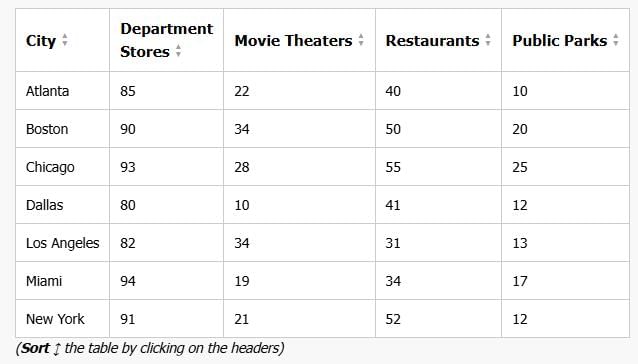GMAT Exam > GMAT Questions > The above table shows, for different cities, ...
Start Learning for Free

The above table shows, for different cities, the percentage of population of a city which is a regular visitor to different locations in the city. For example: 85% of the people in Atlanta are regular visitors to department stores, and 12% of the people in New York are regular visitors to public parks.
Select Would Explain if the statement explains some of the information in the table. Otherwise, select Would not Explain.

- a)Part 1: Would Not Explain
Part 2: Would Not Explain
Part 3: Would Not Explain - b)Part 1: Would Not Explain
Part 2: Would Explain
Part 3: Would Not Explain - c)Part 1: Would Not Explain
Part 2: Would Explain
Part 3: Would Explain - d)Part 1: Would Explain
Part 2: Would Explain
Part 3: Would Explain - e)Part 1: Would Explain
Part 2: Would Not Explain
Part 3: Would Not Explain
Correct answer is option 'A'. Can you explain this answer?
Most Upvoted Answer
The above table shows, for different cities, the percentage of populat...
A. A majority of people living in these cities do not have easy access to a public park.
>>ACCESS – cant not be commented ; maybe these visitors are not interested to go even after having access
WOULD NOT EXPLAIN
B. The proportion of residents that live in the proximity of a movie theater is lower in Dallas than that in Boston and Los Angeles.
>>Dallas= 41% ; boston = 50% and LA= 31%
But it is hard to mention the number of residents in total
WOULD NOT EXPLAIN
C. The proportion if people who prefer to spend time indoors is greater in Dallas than in Chicago.
>>Dallas indoors= it is not right to explain that 82% in departmental stores are same people or different people moving to theatres, restaurants or public parks
Similarly for Chicago ; no detail infromtion is given
WOULD NOT EXPLAIN
>>ACCESS – cant not be commented ; maybe these visitors are not interested to go even after having access
WOULD NOT EXPLAIN
B. The proportion of residents that live in the proximity of a movie theater is lower in Dallas than that in Boston and Los Angeles.
>>Dallas= 41% ; boston = 50% and LA= 31%
But it is hard to mention the number of residents in total
WOULD NOT EXPLAIN
C. The proportion if people who prefer to spend time indoors is greater in Dallas than in Chicago.
>>Dallas indoors= it is not right to explain that 82% in departmental stores are same people or different people moving to theatres, restaurants or public parks
Similarly for Chicago ; no detail infromtion is given
WOULD NOT EXPLAIN

|
Explore Courses for GMAT exam
|

|
Question Description
The above table shows, for different cities, the percentage of population of a city which is a regular visitor to different locations in the city. For example: 85% of the people in Atlanta are regular visitors to department stores, and 12% of the people in New York are regular visitors to public parks.Select Would Explain if the statement explains some of the information in the table. Otherwise, select Would not Explain.a)Part 1:Would Not ExplainPart 2:Would Not ExplainPart 3:Would Not Explainb)Part 1:Would Not ExplainPart 2:Would ExplainPart 3:Would Not Explainc)Part 1:Would Not ExplainPart 2:Would ExplainPart 3:Would Explaind)Part 1:Would ExplainPart 2:Would ExplainPart 3:Would Explaine)Part 1:Would ExplainPart 2:Would Not ExplainPart 3:Would Not ExplainCorrect answer is option 'A'. Can you explain this answer? for GMAT 2025 is part of GMAT preparation. The Question and answers have been prepared according to the GMAT exam syllabus. Information about The above table shows, for different cities, the percentage of population of a city which is a regular visitor to different locations in the city. For example: 85% of the people in Atlanta are regular visitors to department stores, and 12% of the people in New York are regular visitors to public parks.Select Would Explain if the statement explains some of the information in the table. Otherwise, select Would not Explain.a)Part 1:Would Not ExplainPart 2:Would Not ExplainPart 3:Would Not Explainb)Part 1:Would Not ExplainPart 2:Would ExplainPart 3:Would Not Explainc)Part 1:Would Not ExplainPart 2:Would ExplainPart 3:Would Explaind)Part 1:Would ExplainPart 2:Would ExplainPart 3:Would Explaine)Part 1:Would ExplainPart 2:Would Not ExplainPart 3:Would Not ExplainCorrect answer is option 'A'. Can you explain this answer? covers all topics & solutions for GMAT 2025 Exam. Find important definitions, questions, meanings, examples, exercises and tests below for The above table shows, for different cities, the percentage of population of a city which is a regular visitor to different locations in the city. For example: 85% of the people in Atlanta are regular visitors to department stores, and 12% of the people in New York are regular visitors to public parks.Select Would Explain if the statement explains some of the information in the table. Otherwise, select Would not Explain.a)Part 1:Would Not ExplainPart 2:Would Not ExplainPart 3:Would Not Explainb)Part 1:Would Not ExplainPart 2:Would ExplainPart 3:Would Not Explainc)Part 1:Would Not ExplainPart 2:Would ExplainPart 3:Would Explaind)Part 1:Would ExplainPart 2:Would ExplainPart 3:Would Explaine)Part 1:Would ExplainPart 2:Would Not ExplainPart 3:Would Not ExplainCorrect answer is option 'A'. Can you explain this answer?.
The above table shows, for different cities, the percentage of population of a city which is a regular visitor to different locations in the city. For example: 85% of the people in Atlanta are regular visitors to department stores, and 12% of the people in New York are regular visitors to public parks.Select Would Explain if the statement explains some of the information in the table. Otherwise, select Would not Explain.a)Part 1:Would Not ExplainPart 2:Would Not ExplainPart 3:Would Not Explainb)Part 1:Would Not ExplainPart 2:Would ExplainPart 3:Would Not Explainc)Part 1:Would Not ExplainPart 2:Would ExplainPart 3:Would Explaind)Part 1:Would ExplainPart 2:Would ExplainPart 3:Would Explaine)Part 1:Would ExplainPart 2:Would Not ExplainPart 3:Would Not ExplainCorrect answer is option 'A'. Can you explain this answer? for GMAT 2025 is part of GMAT preparation. The Question and answers have been prepared according to the GMAT exam syllabus. Information about The above table shows, for different cities, the percentage of population of a city which is a regular visitor to different locations in the city. For example: 85% of the people in Atlanta are regular visitors to department stores, and 12% of the people in New York are regular visitors to public parks.Select Would Explain if the statement explains some of the information in the table. Otherwise, select Would not Explain.a)Part 1:Would Not ExplainPart 2:Would Not ExplainPart 3:Would Not Explainb)Part 1:Would Not ExplainPart 2:Would ExplainPart 3:Would Not Explainc)Part 1:Would Not ExplainPart 2:Would ExplainPart 3:Would Explaind)Part 1:Would ExplainPart 2:Would ExplainPart 3:Would Explaine)Part 1:Would ExplainPart 2:Would Not ExplainPart 3:Would Not ExplainCorrect answer is option 'A'. Can you explain this answer? covers all topics & solutions for GMAT 2025 Exam. Find important definitions, questions, meanings, examples, exercises and tests below for The above table shows, for different cities, the percentage of population of a city which is a regular visitor to different locations in the city. For example: 85% of the people in Atlanta are regular visitors to department stores, and 12% of the people in New York are regular visitors to public parks.Select Would Explain if the statement explains some of the information in the table. Otherwise, select Would not Explain.a)Part 1:Would Not ExplainPart 2:Would Not ExplainPart 3:Would Not Explainb)Part 1:Would Not ExplainPart 2:Would ExplainPart 3:Would Not Explainc)Part 1:Would Not ExplainPart 2:Would ExplainPart 3:Would Explaind)Part 1:Would ExplainPart 2:Would ExplainPart 3:Would Explaine)Part 1:Would ExplainPart 2:Would Not ExplainPart 3:Would Not ExplainCorrect answer is option 'A'. Can you explain this answer?.
Solutions for The above table shows, for different cities, the percentage of population of a city which is a regular visitor to different locations in the city. For example: 85% of the people in Atlanta are regular visitors to department stores, and 12% of the people in New York are regular visitors to public parks.Select Would Explain if the statement explains some of the information in the table. Otherwise, select Would not Explain.a)Part 1:Would Not ExplainPart 2:Would Not ExplainPart 3:Would Not Explainb)Part 1:Would Not ExplainPart 2:Would ExplainPart 3:Would Not Explainc)Part 1:Would Not ExplainPart 2:Would ExplainPart 3:Would Explaind)Part 1:Would ExplainPart 2:Would ExplainPart 3:Would Explaine)Part 1:Would ExplainPart 2:Would Not ExplainPart 3:Would Not ExplainCorrect answer is option 'A'. Can you explain this answer? in English & in Hindi are available as part of our courses for GMAT.
Download more important topics, notes, lectures and mock test series for GMAT Exam by signing up for free.
Here you can find the meaning of The above table shows, for different cities, the percentage of population of a city which is a regular visitor to different locations in the city. For example: 85% of the people in Atlanta are regular visitors to department stores, and 12% of the people in New York are regular visitors to public parks.Select Would Explain if the statement explains some of the information in the table. Otherwise, select Would not Explain.a)Part 1:Would Not ExplainPart 2:Would Not ExplainPart 3:Would Not Explainb)Part 1:Would Not ExplainPart 2:Would ExplainPart 3:Would Not Explainc)Part 1:Would Not ExplainPart 2:Would ExplainPart 3:Would Explaind)Part 1:Would ExplainPart 2:Would ExplainPart 3:Would Explaine)Part 1:Would ExplainPart 2:Would Not ExplainPart 3:Would Not ExplainCorrect answer is option 'A'. Can you explain this answer? defined & explained in the simplest way possible. Besides giving the explanation of
The above table shows, for different cities, the percentage of population of a city which is a regular visitor to different locations in the city. For example: 85% of the people in Atlanta are regular visitors to department stores, and 12% of the people in New York are regular visitors to public parks.Select Would Explain if the statement explains some of the information in the table. Otherwise, select Would not Explain.a)Part 1:Would Not ExplainPart 2:Would Not ExplainPart 3:Would Not Explainb)Part 1:Would Not ExplainPart 2:Would ExplainPart 3:Would Not Explainc)Part 1:Would Not ExplainPart 2:Would ExplainPart 3:Would Explaind)Part 1:Would ExplainPart 2:Would ExplainPart 3:Would Explaine)Part 1:Would ExplainPart 2:Would Not ExplainPart 3:Would Not ExplainCorrect answer is option 'A'. Can you explain this answer?, a detailed solution for The above table shows, for different cities, the percentage of population of a city which is a regular visitor to different locations in the city. For example: 85% of the people in Atlanta are regular visitors to department stores, and 12% of the people in New York are regular visitors to public parks.Select Would Explain if the statement explains some of the information in the table. Otherwise, select Would not Explain.a)Part 1:Would Not ExplainPart 2:Would Not ExplainPart 3:Would Not Explainb)Part 1:Would Not ExplainPart 2:Would ExplainPart 3:Would Not Explainc)Part 1:Would Not ExplainPart 2:Would ExplainPart 3:Would Explaind)Part 1:Would ExplainPart 2:Would ExplainPart 3:Would Explaine)Part 1:Would ExplainPart 2:Would Not ExplainPart 3:Would Not ExplainCorrect answer is option 'A'. Can you explain this answer? has been provided alongside types of The above table shows, for different cities, the percentage of population of a city which is a regular visitor to different locations in the city. For example: 85% of the people in Atlanta are regular visitors to department stores, and 12% of the people in New York are regular visitors to public parks.Select Would Explain if the statement explains some of the information in the table. Otherwise, select Would not Explain.a)Part 1:Would Not ExplainPart 2:Would Not ExplainPart 3:Would Not Explainb)Part 1:Would Not ExplainPart 2:Would ExplainPart 3:Would Not Explainc)Part 1:Would Not ExplainPart 2:Would ExplainPart 3:Would Explaind)Part 1:Would ExplainPart 2:Would ExplainPart 3:Would Explaine)Part 1:Would ExplainPart 2:Would Not ExplainPart 3:Would Not ExplainCorrect answer is option 'A'. Can you explain this answer? theory, EduRev gives you an
ample number of questions to practice The above table shows, for different cities, the percentage of population of a city which is a regular visitor to different locations in the city. For example: 85% of the people in Atlanta are regular visitors to department stores, and 12% of the people in New York are regular visitors to public parks.Select Would Explain if the statement explains some of the information in the table. Otherwise, select Would not Explain.a)Part 1:Would Not ExplainPart 2:Would Not ExplainPart 3:Would Not Explainb)Part 1:Would Not ExplainPart 2:Would ExplainPart 3:Would Not Explainc)Part 1:Would Not ExplainPart 2:Would ExplainPart 3:Would Explaind)Part 1:Would ExplainPart 2:Would ExplainPart 3:Would Explaine)Part 1:Would ExplainPart 2:Would Not ExplainPart 3:Would Not ExplainCorrect answer is option 'A'. Can you explain this answer? tests, examples and also practice GMAT tests.

|
Explore Courses for GMAT exam
|

|
Signup for Free!
Signup to see your scores go up within 7 days! Learn & Practice with 1000+ FREE Notes, Videos & Tests.























